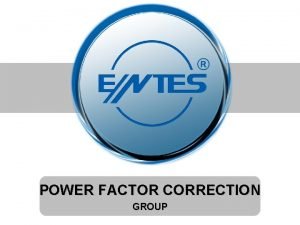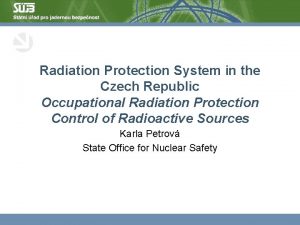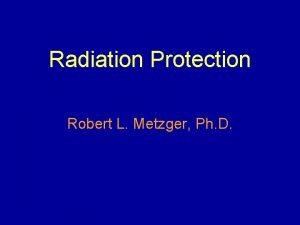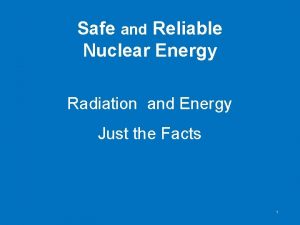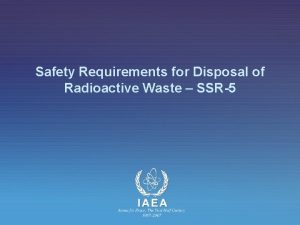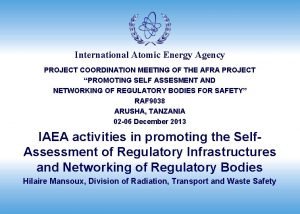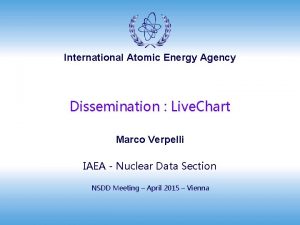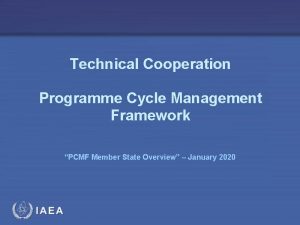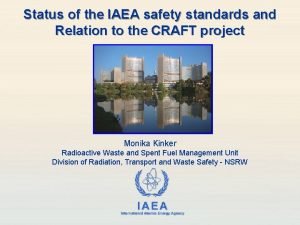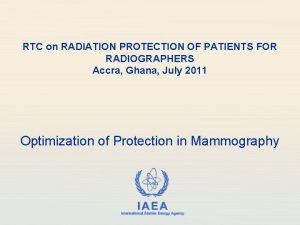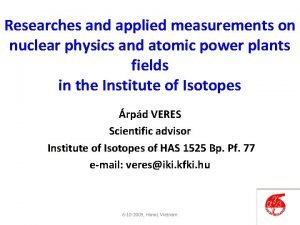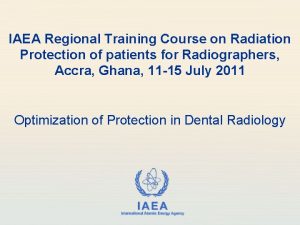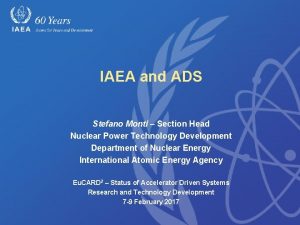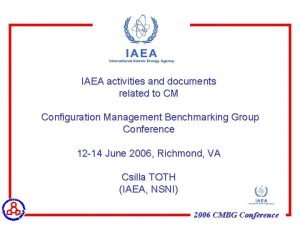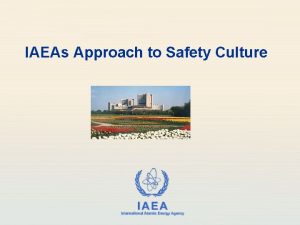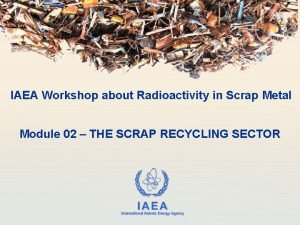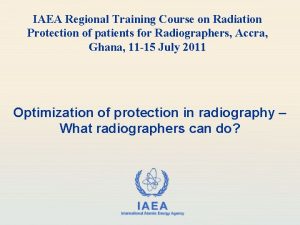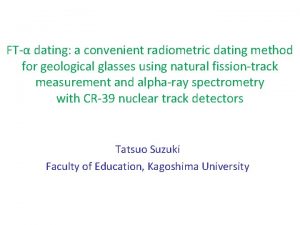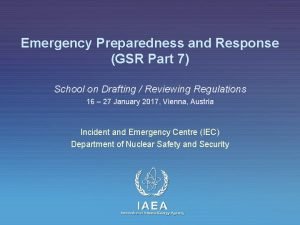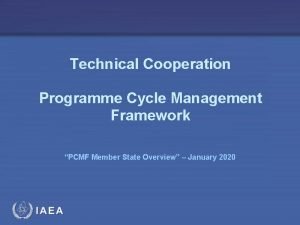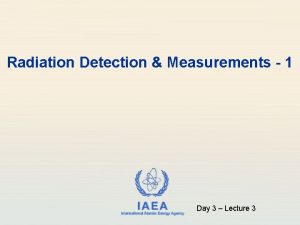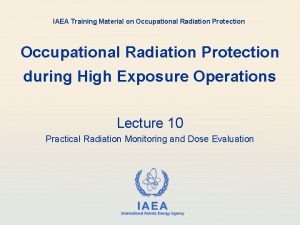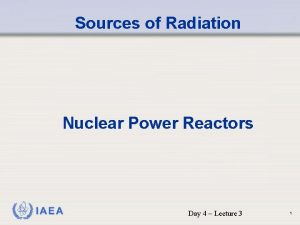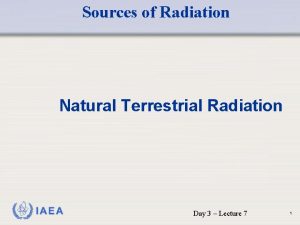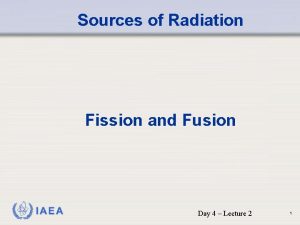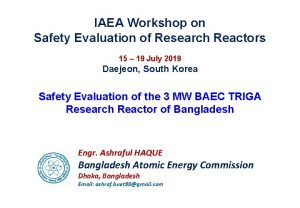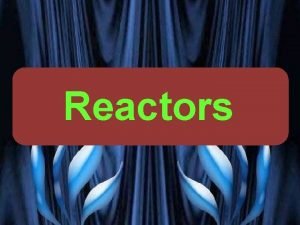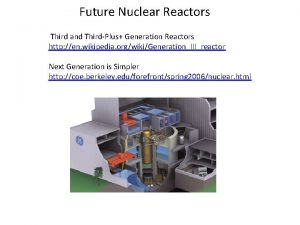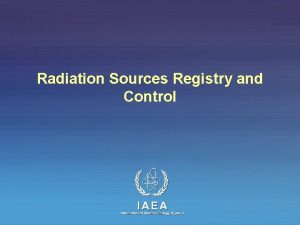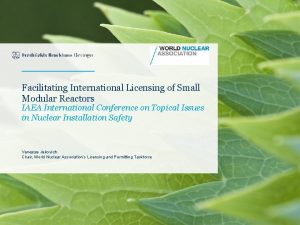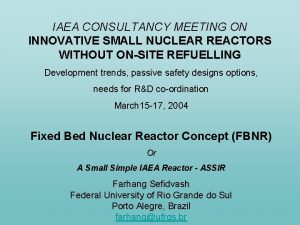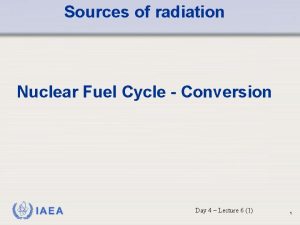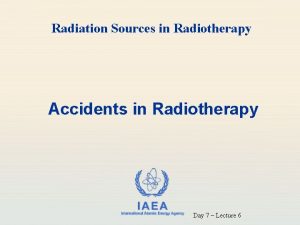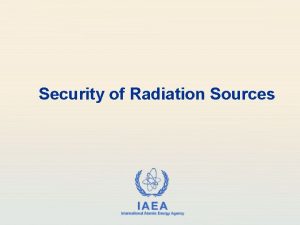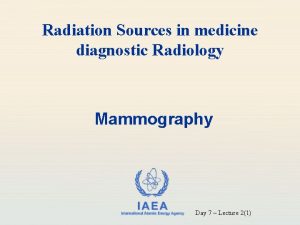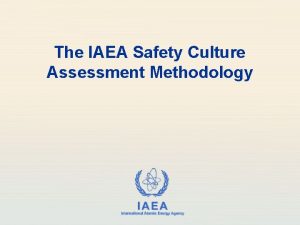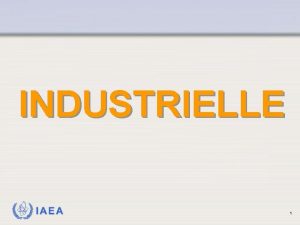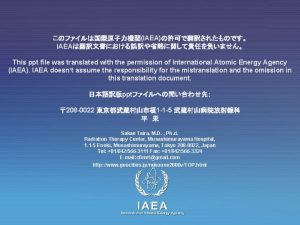Sources of Radiation Research Reactors IAEA Day 4

























- Slides: 25

Sources of Radiation Research Reactors IAEA Day 4 – Lecture 4 1

Objective To discuss the types and uses of Research Reactors IAEA 2

Contents § Types of Research Reactors • Pool Type Reactor • TRIGA Reactors • Other Reactors/ Critical Assemblies § Uses of Research Reactors IAEA 3

Introduction Ø Research Reactors Ø Not used to generate electrical power Ø Produce neutrons for various uses Ø Use higher enriched 235 U than power reactors Ø Approximately 266 in operation worldwide (January 2014) IAEA 4

Types Ø Pool type (61 units)* Ø Curved aluminum clad fuel plates Ø Control rods Ø Water for moderation and cooling Ø Beryllium or graphite neutron reflectors common Ø Empty channels for experiments Ø Apertures for neutron beams Ø Tank Type (27 units)* IAEA * Research Reactors data is from Jan. 2014 5

Pool Type Reactor IAEA 6

Test Reactors The Materials Test Reactor (MTR) completed in 1952 in Idaho was the workhorse of the U. S. Atomic Energy Commission's test reactor program for many years. It was the first reactor to be built solely for testing materials to be used in other reactors. IAEA 7

Types Ø TRIGA (37 units)* Ø 60 -100 cylindrical fuel elements (36 mm diameter) Ø Uranium fuel and zirconium hydride moderator Ø Water for moderation and cooling Ø Beryllium or graphite neutron reflectors common Ø Operate at thermal power levels from less than 0. 1 to 16 megawatts and pulsed to 25, 000 MW IAEA 8 * Data from Jan. 2014

TRIGA IAEA 9

Types Type Critical assemblies (zero power) Test reactors Number* 79 15 Training facilities 21 Prototypes 2 Generating electricity 1 Research Some produce radioisotopes IAEA * Data from Jan. 2014 138 10

Types Ø Some moderated by heavy water (10) or graphite Ø Some are fast reactors (no moderator and mixed U - Pu fuel) IAEA 11

Uses Ø Ø Ø Ø Analysis and testing of material Production of radioisotopes Fusion research Environmental science Advanced material development Drug design Nuclear medicine IAEA 12

Uses IAEA 13

Uses Ø Neutron scattering experiments to study structure of materials at atomic level Ø Neutron activation for detecting presence of small amounts of material IAEA 14

Uses Ø Radioisotope production Ø 90 Y Ø 99 Mo IAEA from 89 Y for treatment of liver cancer from fission of 235 U foil to produce 99 m. Tc for nuclear medicine 15

Uses Ø Industrial processing Ø Neutron transmutation doping of silicon crystals Ø Study changes resulting from intense neutron bombardment (e. g. , embrittlement of steel) IAEA 16

Chicago Pile Reactors CP-2 IAEA 17

Zero Power Reactor Ø zero‑power full‑scale reactor core mockup assemblies used to: Ø gain understanding of a variety of reactor concepts Ø assist in the engineering design of these reactor systems IAEA 18

Zero Power Reactor ZPR‑ 2, a heavy‑water reactor, began operation in 1952 and was used in the development of the Savannah power reactors used for plutonium production IAEA 19

Zero Power Reactor ZPR‑ 6, designed to advance fast reactor technology for civilian power use, went into operation in July 1963 IAEA 20

SLOWPOKE Central control rod Small sample irradiation tube Large sample irradiation tube Beryllium annulus Lower beryllium reflector IAEA 21

SLOWPOKE Ø prime functions are to perform nondestructive elemental analysis and produce quantities of selected radioactive material for use in industry and medicine Ø SLOWPOKE laboratories have been utilized in a number of different fields such as: Ø Ø Ø Trace element identification Radiotracer supply Forensic science Environmental analysis Radioactivity counting IAEA 22

SLOWPOKE Reactor Specifications Type Pool and Tank Licensed limit 20 k. W Fuel Extruded Uranium/aluminum alloy Moderator Light water Cooling Convection/conduction Core diameter/height 22 cm/22. 1 cm Critical mass 235 U 816. 664 g Fuel life 6. 4 x 1019 nvt (at small inner sites) Irradiation Parameters Parameter Inner Sites Outer Sites Thermal flux 1 x 1012 0. 5 x 1012 IAEA 23

High Flux Isotope Reactor IAEA 24

Where to Get More Information Ø Cember, H. , Johnson, T. E, Introduction to Health Physics, 4 th Edition, Mc. Graw-Hill, New York (2009) Ø International Atomic Energy Agency, Postgraduate Educational Course in Radiation Protection and the Safety of Radiation Sources (PGEC), Training Course Series 18, IAEA, Vienna (2002) Ø IAEA Research Reactor Database http: //nucleus. iaea. org/RRDB/RR/Reactor. Search. aspx? rf=1 IAEA 25
 Shunt reactors for power factor correction
Shunt reactors for power factor correction Day 1 day 2 day 3 day 4
Day 1 day 2 day 3 day 4 Day 1 day 2 day 817
Day 1 day 2 day 817 Ionizing radiation sources
Ionizing radiation sources Ionizing radiation sources
Ionizing radiation sources Nuclear energy
Nuclear energy Print and web sources
Print and web sources Importance of water resource
Importance of water resource Iaea ssr-5
Iaea ssr-5 Saris iaea
Saris iaea Livechart iaea
Livechart iaea Succequent
Succequent Part5ds
Part5ds Iaea
Iaea Nuclear wastes
Nuclear wastes Iaea
Iaea Stefano monti iaea
Stefano monti iaea Iaea
Iaea Iaea
Iaea Iaea
Iaea Iaea
Iaea Iaea
Iaea Iaea gsr part 7
Iaea gsr part 7 Pcmf iaea
Pcmf iaea Film badge dosimeter
Film badge dosimeter Iaea
Iaea
